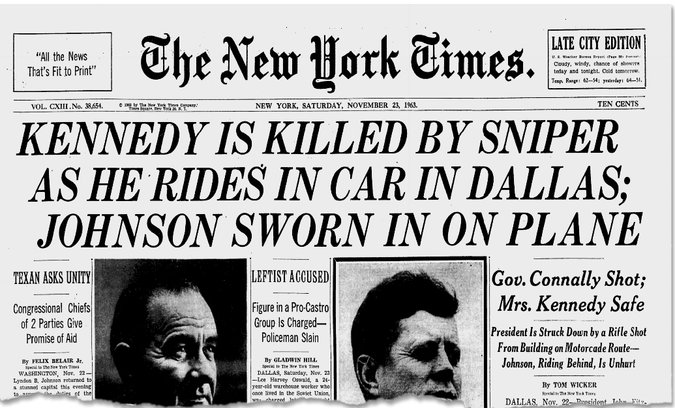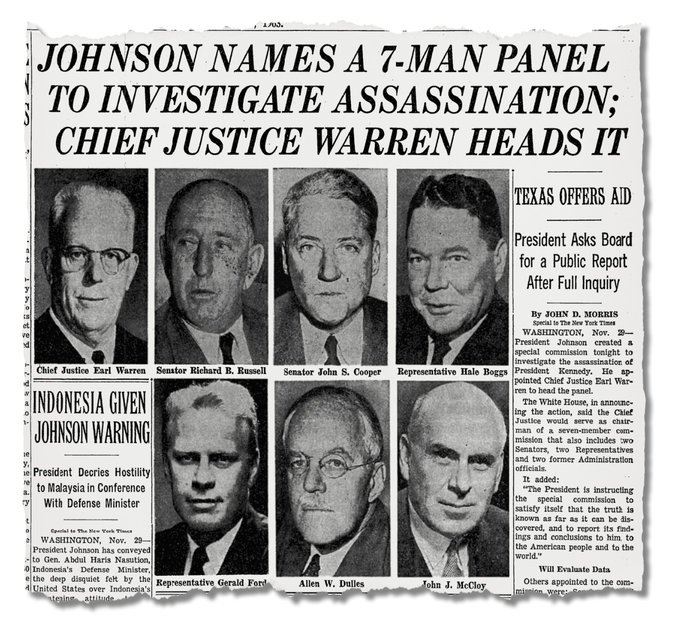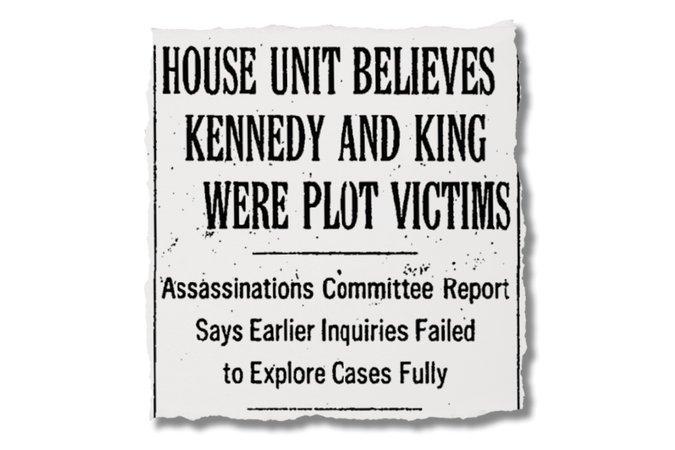The granddaddy of all conspiracy theories has re-emerged in the American psyche with the planned release of the National Archives’s final trove of records about the assassination of President John F. Kennedy.
Kennedy’s death on Nov. 22, 1963, and the numerous investigations that followed were simultaneously some of the most secretive and public events in modern history.
The last of the sealed government papers relating to the assassination are expected to be made public by Thursday, after President Trump announced last week that he would not block their release.
Government agencies, Hollywood big shots and amateur sleuths have floated theories of what happened to Kennedy: a plot by Cold War adversaries like Cuba and the Soviet Union; an elaborate mafia-backed hit; a covert federal government coup. And it’s been going on for over 50 years.
From our partners:
‘A wound in the brain’
Kennedy’s was one of the most public murders in history, a victim shot in front of hundreds of spectators, with a coterie of news reporters in tow. Page One of The Times blared the news of the assassination, reporting that “he died of a wound in the brain caused by a rifle bullet that was fired at him as he was riding through downtown Dallas in a motorcade.”
The report chronicled the swift chaos of the day, from Kennedy’s pre-breakfast speech to Lyndon B. Johnson’s swearing-in as president on Air Force One a few hours later.
Mr. Johnson, who was uninjured in the shooting, took his oath in the Presidential jet plane as it stood on the runway at Love Field. The body of Mr. Kennedy was aboard. Immediately after the oath-taking, the plane took off for Washington.
Standing beside the new President as Mr. Johnson took the oath of office was Mrs. John F. Kennedy. Her stockings were spattered with her husband’s blood.
Lee Harvey Oswald
“Lee H. Oswald, who once defected to the Soviet Union and who has been active in the Fair Play for Cuba Committee, was arrested by the Dallas police,” The Times reported on the same front page. “Tonight he was accused of the killing.”
Immediately after the shooting, a witness told reporters that as “shots rang out he saw a rifle extended and then withdrawn from a window on the “fifth or sixth floor” of the Texas School Book Depository.
Oswald, a former Marine, had become “a changed man with a new and bewildering personality when he returned to the United States in 1962,” according to his wife, Marina, whom he married while living in Russia.
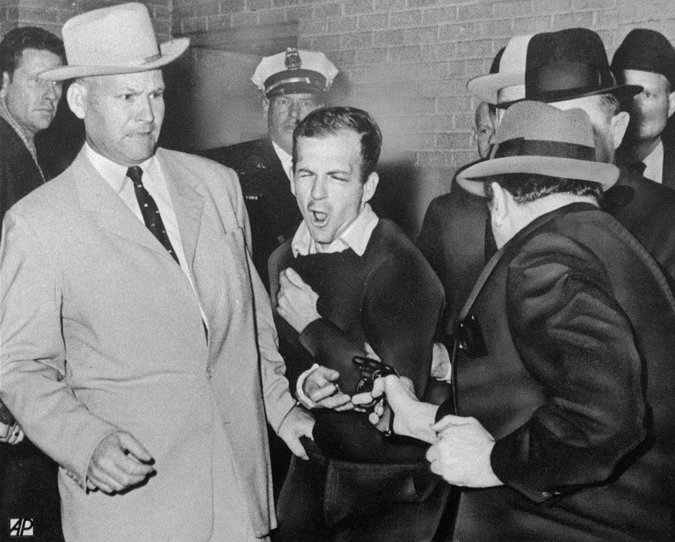
He was famously shot dead by Jack Ruby while in police custody on Nov. 24, two days after the assassination.
The Warren Commission: discrediting ‘myths’
A week after Kennedy’s death, Johnson convened a government body to investigate it, led by Chief Justice Earl Warren.
The nearly yearlong investigation included the private testimony of Jacqueline Kennedy. Many of the findings, like the infamous “magic-bullet theory,” have been contested.
Ultimately, the commission ruled that Oswald had acted alone, rejecting any idea that Russia or Cuba officially backed him, but demanded reforms from the F.B.I. and the Secret Service.
The commission, saying that the “‘publicizing of unchecked information’ had led to ‘myths’ and ‘distorted’ interpretations,” also tried to discredit the multiplying conspiracy theories behind the assassination. It didn’t work.
Investigated again. And again.
At least two more official federal government panels convened in the 1960s and ’70s to relitigate the shooting. In 1969, Attorney General Ramsey Clark appointed four medical experts to re-examine scientific evidence, in part as a response to an investigation by the New Orleans district attorney, Jim Garrison. Clark’s panel backed the Warren Commission’s assertion that only two bullets had killed the president.
In 1979, the House Select Committee on Assassinations, dogged by internal strife during its two and a half years of existence, released a report saying that untold conspirators had probably participated in the killing, citing newly uncovered evidence and scientific advances.
According to the committee, Oswald fired three shots from the sixth floor window of the Texas School Book Depository Building and an unidentified person fired one shot from the grassy knoll in front of the President’s limousine.
The committee cited witnesses in its findings of a second gunman, including:
… a police officer who said he heard a shot from the knoll and ran immediately toward it. There he encountered a man who said he was with the Secret Service and displayed a badge, which the policemen did not inspect very closely.
A check of the placement of Secret Service agents, however, disclosed that none had been in the area of the knoll.
Over the years, the Warren Commission findings remained in doubt in some circles. In 1988, David W. Belin, a lawyer who had advised the commission, wrote:
Yet 25 years after the event, a majority of the American public does not believe the truth. Rather, polls have shown that most Americans believe President Kennedy was assassinated as an outgrowth of a conspiracy.
In 1991, the conspiracy reignited in the form of a major Hollywood movie.
‘J.F.K.’ and rewriting history
In 1969, a jury took only 50 minutes to acquit a man named Clay Shaw of conspiring to assassinate Kennedy.
The Oliver Stone movie “J.F.K.” in 1991 reimagined both that 34-day trial, called a “circus” by many, and the extensive investigation by Garrison, the New Orleans district attorney.
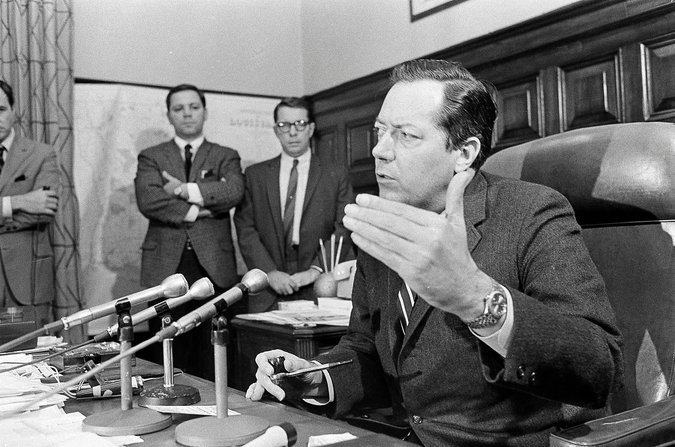
As The Times wrote in Garrison’s 1992 obituary:
Announcing that he had “solved the assassination,” Mr. Garrison accused anti-Communist and anti-Castro extremists in the Central Intelligence Agency of plotting the President’s death to thwart an easing of tension with the Soviet Union and Cuba, and to prevent a retreat from Vietnam.
Garrison, whom The Times described in a lengthy 1967 profile as a headline-seeking crusader with political aspirations long before the Shaw trial, was an adviser for the film, which renewed calls for answers but was criticized by many as a rewriting of history.
Mr. Stone addressed these accusations in a Times Op-Ed:
My critics are outraged that I pose the view that Kennedy’s desire to wind down the cold war and the Vietnam War is a possible motive for the murder. When a leader of any country is assassinated, the media normally ask: “What political forces were opposed to this leader and would benefit from his assassination?”
The film is partly credited with the passage, the year after it was released, of the President John F. Kennedy Assassination Records Collection Act. The law mandated the release of all the government archives on the assassination within 25 years, by Oct. 26, 2017.
Case closed? It’s more complicated than that
Thousands of records have been declassified since, many shedding more light on American foreign policy than on the assassination. Some files detailed the president’s plans to exit the conflict in Vietnam; others showed how Fidel Castro feared the United States would retaliate against Cuba after the assassination. A large trove uncovered the ideas — ranging from the rote to the James Bond-like — that the Pentagon had floated for dealing with Cuba.
Public interest in the most recent release by the National Archives, in July 2017, nearly crashed its servers, Politico reported.
The release of the final papers may only fuel more conspiracy theories, as did the first set of files, made public in 1993:
For those who believe that the assassination was the sole work of Oswald, an ex-marine who had failed in nearly every endeavor, including an attempt to defect to Moscow, the newly released documents offer the final proof. And for those who believe that Oswald did not act alone, the documents also offer substantiation.
“This will feed another generation of assassination buffs, the children of assassination buffs,” said Edward Jay Epstein, who wrote three books and an anthology on the assassination.
This article is written by Lori Moore & originally appeared in New York Times.









